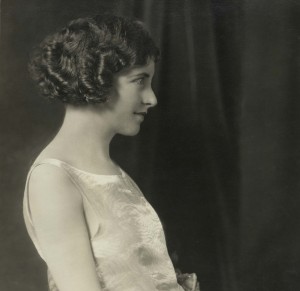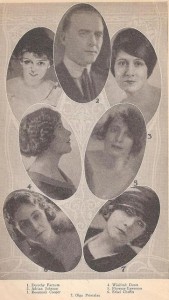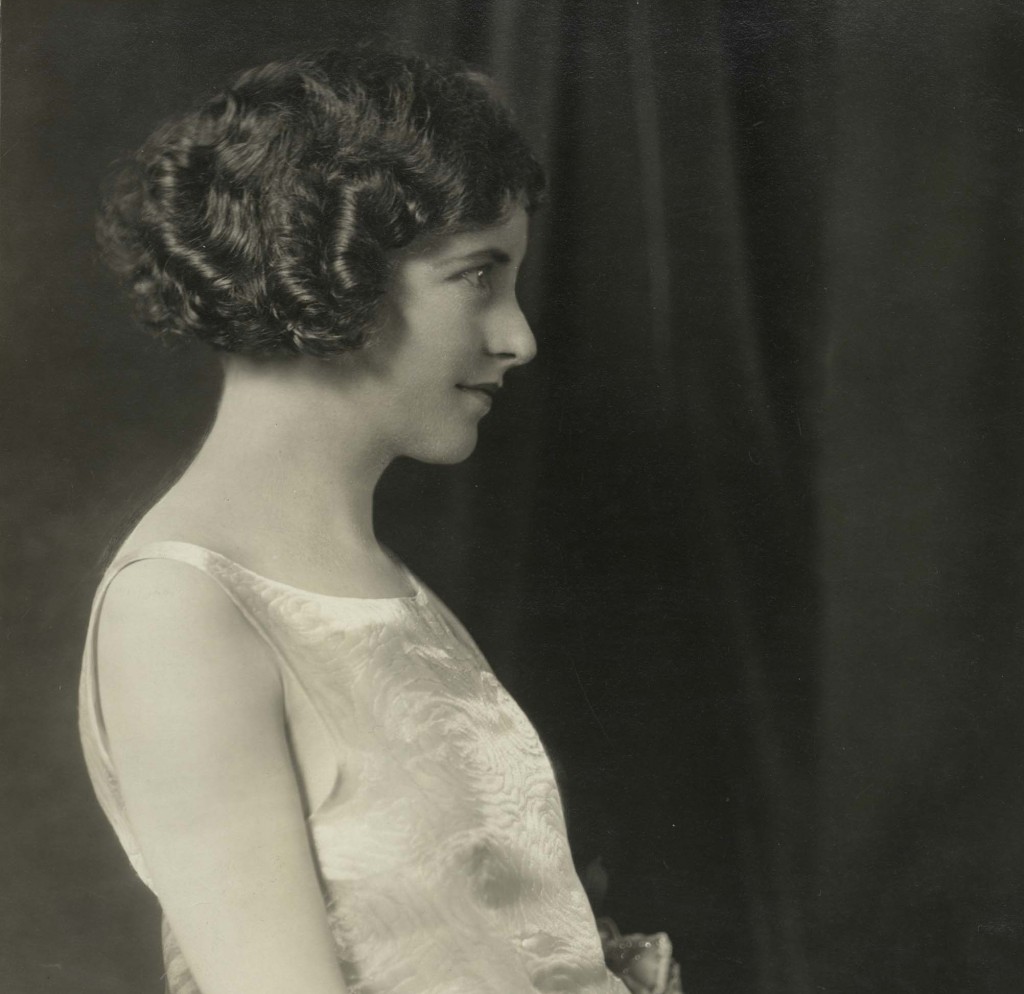by
James Hansen
Known for being one of the youngest scenario editors, male or female, during the silent era, Winifred Dunn, like Anita Loos, started writing at a young age. As a girl in Chicago, Dunn discovered her skills as a writer as well as a translator when at the age of eighteen she translated a German play into English and altered the production to fit an American stage. While still in her teens, Dunn began writing two-reel film plays for Selig Polyscope in New York, where her first original feature Too Late (1914) was produced (II16).

Winifred Dunn portrait. Courtesy of the Museum of the Moving Image.

“The Truth About the Movies,” Dorothy Farnum, Winifred Dunn, Florence Lawrence, Olga Printzlau, Ethel Chaffin, and Rosemary Cooper. Private Collection.
In late 1921 or early 1922, Dunn moved to Hollywood, where she led Sawyer-Lubin Productions for Metro Pictures. During this time, she assisted in editing and titling Quincy Adams Sawyer (1922) and wrote the screen version of Willard Mack’s play “Your Friend and Mine” (1923). Then, on February 10, 1923, at the age of 24, Dunn began her duties as scenario editor at Metro Pictures, which by 1924 would be Metro-Goldwyn-Mayer Studios (B12). Dunn quickly became regarded as one of the busiest scenario editors in Hollywood, where she advocated for writers’ perfecting their craft by the reading of newspapers in order to “keep a metaphorical finger on the pulse of life everywhere” (B36). In 1925, Dunn’s success was taken to new heights when Mary Pickford asked her to handle her future stories (A11). In 1926, Sparrows, the first collaboration between Dunn and Pickford, opened to great acclaim, hailed as Pickford’s “greatest picture” and “a remarkable triumph” (H4). But some controversy arose in June 1927 when Pickford and Dunn were sued for $100,000 by the estate of Harry Hyde for copyright infringement, Hyde claiming that Sparrows was based upon his scenario for The Cry of the Children (3). After the tremendous success of Sparrows, Dunn signed a long-term contract in November 1926 to write scenarios for First National Pictures (A8), the first of which, a prizefighting film entitled The Patent Leather Kid (1927), was noted for its virility, as newspapers asked, “How could a woman know so accurately how bloody noses were made?” (C16). After The Patent Leather Kid, Dunn terminated her contract with First National in order to become the chairman of the woman’s executive committee of the Southern California Olympic Games, which were to be held in Los Angeles in 1933 (C13). Meanwhile, Dunn continued to work as a freelance writer in the late 1920s for studios such as Metro, for The Drop Kick in 1927; and Columbia Pictures, for the early Frank Capra melodrama Submarine in 1928.
In December 1928, the outspoken Dunn was the only woman elected to the writers’ executive committee for the Academy of Motion Picture Arts and Sciences and served as a member of the Executive Board for the Writers’ Guild. Shortly after that, Dunn announced her marriage to sculptor Harold Swartz. This, however, did not stop Dunn from working. She remained an active freelance writer into the sound era through at least 1936, when it was reported that Dunn was working on the first of three features, entitled Everybody’s Boy, with boy singer Bobby Breen for RKO Pictures (27).
See also: Hettie Grey Baker, Katharine Hilliker, Anita Loos, Mary Pickford
Bibliography
“Academy Of Film Arts In Election.” Los Angeles Times (6 Dec. 1928): A5.
“Journal As Text-Book.” Los Angeles Times (29 June 1924): B36.
Kingsley, Grace. "Star In Another French Farce." Los Angeles Times (26 Nov. 1926): A8.
“New Combine To Start Work Soon.” Los Angeles Times (25 May 1924): B12.
“News Of The Screen.” New York Times (23 June 1936): 27.
“Reputation of Well Known Bee Is Tottering.” Los Angeles Times (26 Aug. 1923): III42.
“Scenario Editor at Metro. Youngest Chief Is to Take Charge.” Los Angeles Times (10 Feb. 1923): II16.
“Scenarist Aids Olympic Games.” Los Angeles Times (8 April 1928): C13.
“Scenarist Bride Of Sculptor.” Los Angeles Times (21 Dec. 1928): A3.
Schallert, Edwin. “One of the Screen's Most Thrilling Pictures is ‘Sparrows’.” Los Angeles Times (25 Apr. 1926): H4.
“Sue Mary Pickford For $100,000 Damages.” New York Times (19 June 1927): 3.
Williams, Whitney. “‘Submarine’ Affords Lively Interest.” Los Angeles Times (16 Sept. 1928): I3.
“Winifred Dunn to Write for Mary Pickford.” Los Angeles Times (3 March 1925): A11.
“Woman's Right Script Raises Big Question.” Los Angeles Times (6 March 1927): C16.
Filmography
A. Archival Filmography: Extant Film Titles:
1. Winifred Dunn as Screenwriter
Twinkletoes. Dir.: Charles J. Brabin, sc.: Winifred Dunn (John McCormick Productions. US 1926) cas.: Colleen Moore, Kenneth Harlan, Warner Oland, si, b&w, 8 reels, 7,833 ft. Archive: BFI National Archive, Cinémathèque Royale de Belgique, George Eastman Museum.
The Drop Kick. Dir.: Millard Webb, sc.: Winifred Dunn, Katherine Brush (First National Pictures. US 1927) cas.: Richard Berthelmess, Barbara Kent, Dorothy Revier, si, b&w, 7 reels, 6,900 or 6,819 ft, 16mm. Archive: George Eastman Museum, Library of Congress, UCLA Film & Television Archive.
The Patent Leather Kid. Dir. Alfred Santell, sc.: Winifred Dunn, Adela Rogers St. Johns (First National Pictures. US 1927) cas.: Richard Berthelmess, Molly O’Day, Lawford Davidson, si, b&w, 12 reels, 11,955ft, 16mm & 35mm. Archive: George Eastman Museum, Library of Congress, Cineteca Nazionale, UC Berkeley Art Museum & Pacific Film Archive.
The Tender Hour. Dir.: George Fitzmaurice, sc.: Winifred Dunn (John McCormickProductions. US 1927) cas.: Billie Dove, Ben Lyon, Mantague Love, si, b&w, 8 reels, 7,400 ft, 35mm. Archive: Filmoteca Española, UCLA Film & Television Archive.
Adoration. Dir. Frank Lloyd, sc.: Winifred Dunn (First National Pictures. US 1928) cas.: Billie Dove, Lucy Doraine, Emile Chautard, Winifred Bryson Baxter, si& sd., b&w, 7 reels, 6,609 ft, 35mm. Archive: Cineteca Nazionale, Library of Congress, Academy Film Archive.
Submarine. Dir.: Frank Capra, Irving Willat, sc.: Winifred Dunn, Dorothy Howell, Norman Springer (Columbia Pictures. US 1928) cas.: Jack Holt, Dorothy Revier, Ralph Graves, si, b&w, 8 or 9 reels, 8,374 ft, 35mm. Archive: Library of Congress, EYE Filmmuseum, Cineteca Nazionale, Deutsche Kinemathek.
Mamba. Dir.: Albert Rogell, sc.: Winifred Dunn, Tom Miranda, John Reinhardt, F. Schumann-Heink (Tiffany Productions. US 1930) cas.: Jean Hersholt, Eleanor Boardman, Ralph Forbes, si & sd., b&w, 9 reels, 7,014 ft, 35mm. Archive: Library of Congress, UCLA Film & Television Archive.
B. Filmography: Non-Extant Film Titles:
1. Winifred Dunn as Screenwriter
Too Late, 1914; Wreckage, 1925; Out of the Depths, 1914; And the Children Pay, 1918; Peg o’the Sea, 1918; Human Passions, 1919; It Happened In Paris, 1919; The Red Viper, 1919; Thunderbolts of Fate, 1919; Your Wife and Mine, 1919; Garments of Truth, 1921; Silent Years, 1921; The Glory of Clementina, 1922; Little Eva Ascends, 1922; Two Kinds of Women, 1922; When Love Comes, 1922; Held To Answer, 1923; In Search of a Thrill, 1923; Stormswept, 1923; The Eagle’s Feather, 1923; The Fog, 1923; The Man Whom Life Passed By, 1923; Your Friend and Mine, 1923; Along Came Ruth, 1924; The Shooting of Dan McGrew, 1924; Sparrows, 1926; Lonesome Ladies, 1927.
2. Winifred Dunn as Editor
Quincy Adams Sawyer, 1922; Man and Woman, 1920; The Beauty Prize, 1924.
3. Winifred Dunn as Screenwriter and Editor
Human Passions, 1919; It Happened In Paris, 1919.
Credit Report
There are some discrepancies between FIAF and AFI Databases in regard to Winifred Dunn’s role in Submarine. While FIAF does not list her as being involved in the production, AFI and other reviews and sources I have come across do. There is also some issue with Dunn’s role in Mamba. FIAF, again, does not list Dunn as involved in the production. AFI credits Dunn as a writer and occasionally with continuity. Online sources credit Dunn as a writer for Man and Woman and The Beauty Prize, but neither AFI nor FIAF confirm that status. Finally, there are no records on FIAF of Too Late, Garments of Truth, Little Eva Ascends, Out of the Depths, Bed and Board, Wreckage, or Quincy Adams Sawyer, but several print sources from the Los Angeles Times suggest they were all silent films that Dunn wrote while working for studios throughout her career. AFI has records for Too Late and Quincy Adams Sawyer. The dates listed in the filmography for Garments of Truth, Little Eva Ascends, Out of the Depths and Wreckage are from IMDB and more research needs to be done to verify them. No date has been found yet for Bed and Board, however, there are many films from the 1910s with a similar title.
Citation
Hansen, James. "Winifred Dunn." In Jane Gaines, Radha Vatsal, and Monica Dall’Asta, eds. Women Film Pioneers Project. New York, NY: Columbia University Libraries, 2013. <https://doi.org/10.7916/d8-mr6b-bt07>



